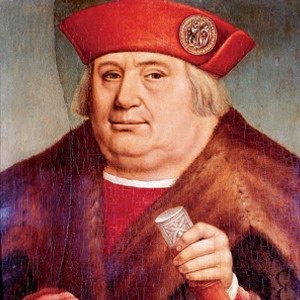Enter Francesco de Tasso of Lombardy (1459-1517), also known in Germany as Franz von Taxis and in France as Francois de Tassis.
Members of the de Tasso family had been operating courier services in some of the Italian city-states since the very end of the 13th century, but things didn't really take off until 1490, when the German king (later Emperor) Maximilian commissioned Francesco, along with his brother and his nephew, to build postal and courier lines throughout the Holy Roman Empire. They responded by setting up the first relay-style postal system (think Pony Express) with stations along the route for the couriers to change horses. By 1505, de Tasso's system was operating in France and Spain as well. He obtained a monopoly on carrying both government and private mail, thus creating the very first mail service to which the public could have access for a fee. De Tasso employed as many of his own relatives as he could, and apparently they shared his work ethic, because the business flourished and was constantly expanding into new locations. In 1512, Maximilian, now an emperor, granted the family a patent of nobility (hence the name VON Taxis). They acquired a fancy coat of arms:
Franz died in 1517, but as international trade increased throughout the 16th century, a dependable postal service became even more indispensable in almost every aspect of life. Well into the 19th century branches of the von Taxis family continued to run both national and local postal services in Spain, Germany, Austria, Italy, Hungary, Belgium and the Netherlands, eventually employing up to 20,000 messengers at a time.
The family also became incredibly wealthy along the way, as you might be able to tell from some glimpses of their humble homestead.
No, these aren't photos of Buckingham Palace, although you could be forgiven for thinking so. Not too shabby for a family of mailmen, am I right?
And as to the Uber reference in my post title: the de Tasso/von Taxis family never did get involved in transporting passengers from place to place, but did you ever wonder where the word "taxi" came from? Well, wonder no more!




Excellent! Great use of the "U" challenge!
ReplyDeleteThank you very much, Martha! I love learning all this stuff and being able to share it with people that enjoy it too!
Deletethat's a great post, thanks for sharing
ReplyDeletehttp://www.obliqview.blogspot.in
Thank you for being such a welcome visitor!
ReplyDeleteOkay, the minute i read his name I knew the etymology of taxi would have something to do with him :) That's two word origins I've come to know from your a-z posts today - zany and taxi. How cool is that?! Thank you.
ReplyDeleteI just saw a photo the other day in a magazine photo spread of the current Princess Von Thurn und Taxis. She was dressed outlandishly and apparently has made some racist public statements recently. Seems like she has way too much time and money on her hands.
DeleteThank you for this excellent piece! Where did you find this map (I mean the postal rates, 1506-1517; there is no citation)?
ReplyDeleteHello, Unknown! Thanks very much! Unfortunately I don't remember where I found the map of postal routes, but I didn't read any books while researching this post, so I have to have found it online somewhere. Hope that helps!
ReplyDeleteMI familia
ReplyDeleteSeriously?? So are you a royal of some sort? Please tell me more!
Delete